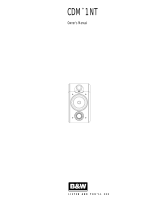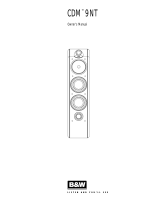Page is loading ...

CONTENTS
English Pg 1
German Pg 2
French Pg 3
Spanish Pg 4
Dutch Pg 5
Italian Pg 6
Danish Pg 7
Portuguese Pg 8

INTRODUCTION
Thank you for purchasing B&W CDS6 Dipole Surround speakers.
These surround speakers conform to the specifications of Lucasfilm
Home THX and differ from most conventional speakers in that they have
a dipolar radiation pattern.
The sound is projected mainly backwards and forwards, with drive units
mounted on opposite sides of the cabinet. Sound radiated in one
direction has the reverse polarity to that radiated in the opposite
direction. In a plane at right angles to these two lobes, the sound is
substantially cancelled out. This is the so called null plane.
The speakers are used with the null plane directed towards the listeners,
who therefore hear very little direct sound. Most of the sound they hear
is reflected off the surfaces of the room and is diffuse in nature. This
gives the enveloping and atmospheric sound field that is necessary for
good Home THX, Dolby Pro Logic and AC3 reproduction.
The CDS6 incorporates a woven Kevlar® cone bass drive unit for lowest
coloration and maximum definition. It also has two paper midrange/high-
frequency units to ensure dipolar dispersion and maintain dynamics to
high sound levels.
However, no matter how good the speakers themselves, they must work
well into the listening room and time spent on planning the installation
will reap the reward of many hours listening pleasure. Please read
through this manual fully. It will help you optimise the performance of
the system.
B&W distribute to over 50 countries world-wide and maintain a network
of dedicated distributors who will be able to help should you have any
problems your dealer cannot resolve.
UNPACKING
Check the contents:
2 x Baffle with drive units, crossover and foam
2 x Wall frame
2 x Loudspeaker grille
1 x Alignment template
1 x Accessory pack containing:
20 x Spring clips + self tapping screws + washers
8 x Machine screws (fixing baffles to wall frames)
We suggest you retain the packaging for future use. Remove the grilles
and baffles from the wall frames and, to avoid damage, keep them in
their plastic bags (and preferably in the carton) away from the work area
until you are ready to fit them.
POSITIONING (figure 1)
Always mount the speakers with the midrange/high-frequency units
pointing towards the front and rear walls. They should preferably be
mounted in the side walls of the room in line with the centre row of
listeners at, or just over, 0.6m (2ft) above head height. If side wall
mounting is not possible, mount the speakers in the ceiling in line with
the listeners, one close to each side wall.
Check that there is no conflict with other in-wall installations (pipe work,
air conditioning, power cabling etc.). In existing construction, use a
stud-finding tool to map the wall construction accurately and a pipe
detector to scan the proposed installation position. Avoid installing the
speakers in the same cavity of the wall as flimsy ducting, which may be
induced to rattle. The speakers are designed to operate satisfactorily in
a wide range of cavity volumes, ideally above 15 litres (0.5 cu ft).
DAMPING THE WALL CAVITY
A foam pad is supplied to damp the area behind the drive units.
In addition, loosely fill the whole section of the wall cavity with wadding.
Fibreglass and mineral wool matting supplied for heat insulation are
suitable, but not closed cell foam or expanded polystyrene. Check that
there is no debris that may fall into the speaker (especially in ceiling
mount situations).
IMPORTANT: YOU SHOULD CHECK THAT THE MATERIALS YOU USE MEET
THE LOCAL FIRE AND BUILDING REGULATIONS.
FITTING THE WALL FRAME
All Methods
Apply sealing compound or mastic to the back side of the outer lip of
the wall frame to provide a seal and prevent rattling.
New Construction (figure 2)
Fit the separately available pre-mount kit - PMK8-to the studding before
the drywall panels are fitted, following the instructions supplied with the
kit. The drywall panels should be fitted up to the pre-mount box and
plastered over.
Screw, but do not tighten, 6 of the screws plus washers provided
through the slots in the wall frame into the pilot holes in the pre-mount
box.
Existing Construction (figure 3)
Push out the slots in the template provided. Position the template on
the wall as required. Mark along the inside edges of the slots and cut out
the aperture neatly.
Ten spring clips are supplied for each wall frame. Screw, but do not
tighten, sufficient of them via the holes in the rear surface of the wall
frame to ensure that it sits properly on the wall surface. Use extra clips
around areas of particular unevenness.
All Methods
Align the frame squarely and tighten down the screws. A certain
amount of flexing of the wall frame is allowed to take up unevenness in
the wall surface, but do not over tighten the screws as excessive
distortion of the frame may impede the fitting of the baffle.
CUSTOMISING
The wall frame is pre-finished in white primer paint, ready if necessary
to be re-finished to match your own decor. Decorate before the baffle
is fitted.
Do not paint the baffle. Remove it before re-decoration. Avoid touching
the drive units, as damage may result.
FITTING THE BAFFLE
AND CONNECTIONS (figure 4)
The baffle is secured to the wall frame by 4 machine screws in the
corners. All connections should be made with the equipment switched
off.
To ensure the correct dipolar sound field, the speakers are handed left
and right. When each speaker is positioned at the correct side of the
room, the positive terminal (coloured red) is nearer the screen.
The terminals accept bare wires. Connect the red (+ve) terminal to the
positive terminal of the amplifier and the black (-ve) to the negative
(figure 5). Failure to observe correct polarity will result in ill-defined
panning of sounds and strange phase effects.
When choosing cable, keep the total electrical impedance (out and back)
below the maximum recommended in the specification. Ask your dealer
for advice, as the optimum cable will depend on the length required. Cut
off excess length and tie down loose cable to prevent rattles.
NOTE: Certain power amplifiers cause a polarity reversal between input
and output. Ensure the polarity convention for all the amplifiers you use
is consistent to avoid ill-defined images. Amplifiers carrying the
Lucasfilm THX symbol are required to be non-inverting.
1

DESCRIPTION:
DRIVE UNITS:
FREQUENCY RANGE:
FREQUENCY RESPONSE:
DISPERSION:
SENSITIVITY:
HARMONIC DISTORTION:
NOMINAL IMPEDANCE:
CROSSOVER FREQUENCY:
RECOMMENDED AMPLIFIER POWER:
MAX. RECOMMENDED CABLE IMPEDANCE:
DIMENSIONS:
RETROFIT CUT-OUT SIZE:
NET WEIGHT:
FINISH:
2-way 2nd-order in-wall THX certified dipole surround system
1x 125mm (5in) dia Kevlar® cone bass
2x 80mm (3in) dia paper cone midrange/high-frequency
-6dB at 63Hz and 12.5kHz
85Hz - 8kHz ±3dB power averaged over front hemisphere
Horizontal: Figure-of-eight dipolar 250Hz - 12kHz
89dB spl (2.83V, 1m)
2nd & 3rd harmonics <1% 85Hz - 20kHz (90dB spl, 1m)
8Ω (minimum 3.5Ω)
250Hz
30W-100W continuous into 8Ω on unclipped programme.
0.2Ω
Height: 285mm (11.2 in)
Width: 373mm (14.7 in)
Depth: 61mm (4.1 in) from wall face
Height: 245mm (9.6 in)
Width: 330mm (13 in)
N.B. Grille protrudes 74mm (3 in) in front of wall surface.
3.5kg (7.7 lb)
White
CDS6
B&W Loudspeakers Ltd. reserves the right to amend specifications without notice in line with technical developments.
Copyright © B&W Loudspeakers Ltd.
B&W Loudspeakers Ltd., Meadow Road, Worthing, BN11 2RX, England Tel: +44 (0) 1903 524801 Fax: +44 (0) 1903 524725 http://www.bwspeakers.com
B&W Loudspeakers of America, 54 Concord Street, North Reading, M.A. 01864-2699, USA.
Printed in England.
I 4740
™
Manufactured under license from Lucasfilm Ltd.
THX and Home THX are registered trademarks of Lucasfilm Ltd.
/








